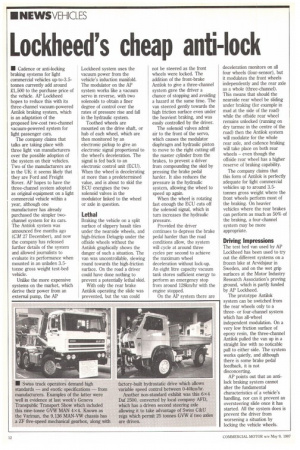Lockheed's cheap anti-lock
Page 14

If you've noticed an error in this article please click here to report it so we can fix it.
• Cadence or anti-locking braking systems for light commercial vehicles up-to-3.5tonnes currently add around £1,500 to the purchase price of the vehicle. AP Lockheed hopes to reduce this with its three-channel vacuum-powered Antilok braking system, which is an adaptation of the proposed low-cost two-channel vacuum-powered system for light passenger cars.
The company claims that talks are taking place with three light van manufacturers over the possible adoption of the system on their vehicles. Two of the manufacturers are in the UK: it seems likely that they are Ford and Freight Rover. AP hopes to have the three-channel system adopted as original equipment on a light commercial vehicle within a year, although one manufacturer has already purchased the simpler twochannel system for its cars. The Antilok system was announced five months ago (CM 27 December), and now the company has released further details of the system and allowed journalists to evaluate its performance when mounted in an unladen 3.5tonne gross weight test-bed vehicle.
Unlike the more expensive systems on the market, which derive their power from an external pump. the AP Lockheed system uses the vacuum power from the vehicle's induction manifold. The modulator on the AP system works like a vacuum servo in reverse, with two solenoids to obtain a finer degree of control over the rates of pressure rise and fall in the hydraulic system.
Toothed wheels are mounted on the drive shaft, or hub of each wheel, which are then monitored by an electronic pickup to give an electronic signal proportional to the wheel's deceleration. The signal is fed back to an electronic control unit (ECU). When the wheel is decelerating at more than a predetermined value, and is about to skid the ECU energises the two solenoid valves in the modulator linked to the wheel or axle in question.
Lethal
Braking the vehicle on a split surface of slippery basalt tiles under the nearside wheels, and high-friction Delugrip under the offside wheels without the Antilok graphically shows the danger of such a situation. The van was uncontrollable, stewing round towards the high-friction surface. On the road a driver could have done nothing to prevent a potentially lethal skid.
With only the rear brake Antilok operating the slide was prevented, but the van could not be steered as the front wheels were locked. The addition of the front-brake Antilok to give a three-channel system gave the driver a chance of stopping and avoiding a hazard at the same time. The van steered gently towards the high friction surface even under the heaviest braking, and was easily controlled by the driver.
The solenoid valves admit air to the front of the servo, which causes the modulator diaphragm and hydraulic piston to move to the right cutting off the master cylinder from the brakes, to prevent a driver from compounding the skid by pressing the brake pedal harder. It also reduces the pressure in the hydraulic system, allowing the wheel to speed up again.
When the wheel is rotating fast enough the ECU cuts off the solenoid signal, which in turn increases the hydraulic pressure.
Provided the driver continues to depress the brake pedal harder than the road conditions allow, the system will cycle at around three cycles per second to achieve the maximum wheel deceleration without lock-up. An eight litre capacity vacuum tank stores sufficient energy to perform an emergency stop from around 128krn/hr with the engine stopped.
On the AP system there are deceleration monitors on all four wheels (four-sensor), but it modulates the front wheels independently and the rear axle as a whole (three-channel). This means that should the nearside rear wheel be sliding under braking (for example in mud at the side of the road) while the offside rear wheel remains unlocked (running on dry tarmac in the centre of the road) then the Antilok system will modulate for the whole rear axle, and cadence braking will take place on both rear wheels – even though the offside rear wheel has a higher reserve of braking capability.
The company claims that this form of Antilok is perfectly adequate for light commercial vehicles up to around 3.5tonnes gross weight where the front wheels perform most of the braking. On heavier vehicles where the rear brakes can perform as much as 50% of the braking, a four-channel system may be more appropriate.
Driving Impressions
The test bed van used by AP Lockheed has been used to try out the different systems on a frozen lake at Arvidsjaur in Sweden, and on the wet grip surfaces at the Motor Industry Research Association's proving ground, which is partly funded by AP Lockheed.
The prototype Antilok system can be switched from the rear wheels only to a threeor four-channel system which has all-wheel independent modulation. On a very low friction surface of epoxy resin, the three-channel Antilok pulled the van up in a straight line with no noticable pull to either side. The system works quietly, and although there is some brake pedal feedback, it is not disconcerting.
AP points out that an antilock braking system cannot alter the fundamental characteristics of a vehicle's handling, nor can it prevent an oversteering slide once it has started. All the system does is prevent the driver from worsening a situation by locking the vehicle wheels.




















































































